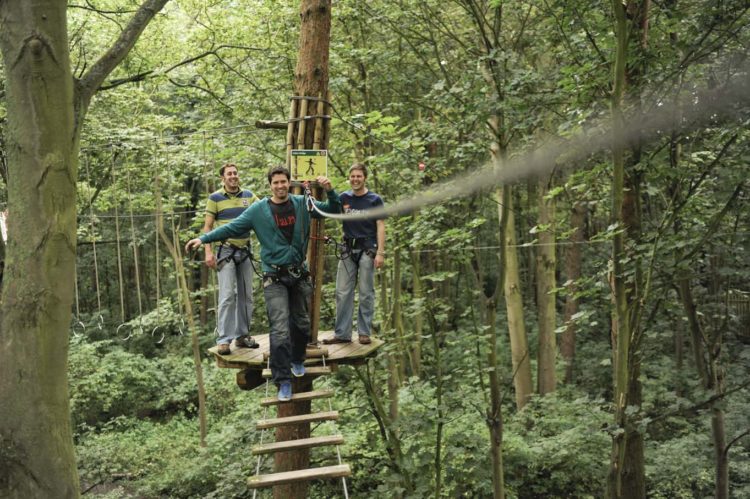I arrived at the Go Ape Treetop Adventure Course in upper Creve Coeur Lake Memorial Park just in time to see a dozen Tarzan wannabes leaving the old powerhouse and walking to the first wooden platform set amid the canopy.
I’d been on a zip line before, so I was pretty sure I knew what I was getting into with this year-old local attraction. Some others? Not so much. But that’s OK, the course is designed for all skill levels and part of the fun is facing your fears. Plus, instructors are always close by if you need help.
After filling out the requisite forms and going through a short orientation, I and those in my group — a range of shapes and sizes, and from ’tweeners to solidly middle-aged — were introduced to the equipment: a harness and the karabiners and trolley that attach to the overhead cables. We spent about 20 minutes reviewing the procedures and click-snap-clicking at the practice station, then headed over to the 2,600 feet of zip lines.
Thanks to my admission that I had “prior experience,” I was moved to the head of the class. Having a trained expert hook you onto a zip line and hooking yourself onto a zip line are two very different things when you’re 40 feet above the ground, I soon discovered, but with breath held I stepped off the wood platform.
Wheeeee! I zoomed 50 feet straight into a cargo net stretched across the end of the run. A real rush!
It’s On Like Kong
But the fun and games had only just begun. Go Ape’s cobweb of cables strung through the trees is interspersed with bridges, ladders, swings, and climbs, creating an obstacle course that could challenge anyone’s inner jungle commando. My opening my big mouth now meant that I had the group’s undivided attention as I attempted — and at first failed — to swiftly and gracefully execute some tricky maneuvers. The Midwest’s first skateboard zip line? Come on, I can barely skate on pavement!
And seldom have I felt so spastic as when I was on the crossing where I had to use foot rings, like stirrups, and step from one to the next using nothing but thin rope to balance my upper body. Several times as I bobbed awkwardly with my legs randomly splitting and splaying, I wondered if I had accidentally signed up for “American Ninja Warrior.”
Once I got the hang of it, thought, I relaxed, enjoying the rides and obstacles and appreciating the scenery below and around me. Go Ape blends beautifully into the deeply ravined and timbered landscape. In fact, one of the course’s founding principles is to be socially and environmentally responsible. Wooden stays prevent cables from digging into tree trunks, and a portion of the proceeds and stewardship services go back to the park.
There are 40 obstacles total within five sections of the course, and I’d be lying if I said my muscles weren’t quivering as we neared the end. Each section takes you higher into the canopy and finishes with a zip line longer and with more expansive views. I whooshed down the final, 400-foot-long zip line with a mighty yell. Oooeeeoooeeeooo!
When it was all said and done, I was even more of a convert to the joys of dangling from wires and swinging between trees like a madcap monkey-man than I was before. I bet you will be, too.
Admission to Go Ape is $57 for adults and $37 for customers 17 and under. Participants must be at least 10 years old and 4 feet 7 inches tall. No one under 18 is allowed on the course without adult supervision. Visit goape.com to check availability and book your adventure.
5 Tips for Newbies
– Allow time. The course takes two to three hours to complete, depending on your pace.
– Pay attention. While instructors are always nearby, you’re on your own and need to know how to work the gear to be safe.
– Dress right. Wear clothes that are loose allow comfortable movement. No sandals, open-toed or slip-on shoes.
– Wear gloves. Though not required, gloves help on rope obstacles, especially as the day goes on.
– Stay connected. If you forget all the other tips, remember to always have one karabiner attached to the safety line at all times while on elevated platforms.
Author: Brad Kovach is the editor of Terrain magazine
Images: Courtesy of Go Ape



Leave A Comment